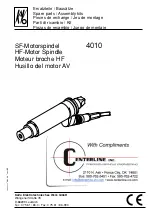
C h e m i s t r y M u l t i M e a s u r e S e n s o r
I n t ro d u ct io n
2
012-09523B
Introduction
The PS-2170 Chemistry MultiMeasure Sensor combines four sensors in a single unit:
The sensor includes a temperature probe, a voltage probe, and a pH electrode. The pressure sensing element does not use an
external probe. The sensor comes with alligator clips and insulators, a syringe, blue polyurethane tubing, and a Hose and Cou-
pling Kit.
When connected to a PASPORT interface, the multi-sensor collects data at up to 100 samples per second from each component
sensor. You can use just one component sensor at a time or any combination simultaneously. If you have a PASPORT interface
that supports multiple sensors, or if you have more than one interface connected to your computer, you can use the Chemistry
MultiMeasure Sensor in combination with other PASPORT sensors.
Sensor, Interface, and Software Setup
Connect the multi-sensor to your PASPORT interface as pictured (right). Connect any
or all of the included probes to the multi-sensor. (You can leave any of the probes dis-
connected if you do not plan to use it.) If you will be using a pH Electrode (included)
or an ion-selective electrode or oxygen reduction potential electrode, connect it to the
pH/ISE/ORP port (BNC port). Align the grooves of the BNC connector on the probe
with the pins on the BNC port. Push the connector onto the port and turn the connector
clockwise until it locks in place. If you plan to measure pressure in an apparatus or the
included syringe, connect it to the sensor’s pressure port using the included clear tub-
ing and a quick-release connector.
For detailed information about each of the multi-sensor sensor’s component sensors
see pages 4–6.
Follow the instructions in the Computer Setup section to set up the sensor with a
PASPORT-compatible interface connected to a computer using PASCO Capstone or
SPARKvue HD software.
Follow the instructions in the Wireless Setup section to set up the sensor with a mobile
device such as a tablet or smart phone using a wireless interface such as the AirLink2
or SPARKlink and the SPARKvue HD software
Follow the instructions in the Hand-Held Setup section to set up the sensor with a SPARK Science Learning System (SPARK
SLS) or the Xplorer GLX hand-held data-logger.
Optional Equipment
Note
Fast-response Temperature Probe
PS-2135 (3-pack)
Skin/surface Temperature Probe
PS-2131
Various Ion-selective Electrodes (ISE)
See PASCO catalog or
www.pasco.com
Oxidation Reduction Potential (ORP) Electrode
CI-6716
•
Temperature
•
Absolute gas pressure (built-in)
•
pH, ORP, and ion-selective electrode voltage
•
Voltage
Pressure
Port
BNC
Port
Voltage
Temperature
PASPORT
Interface






























